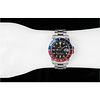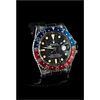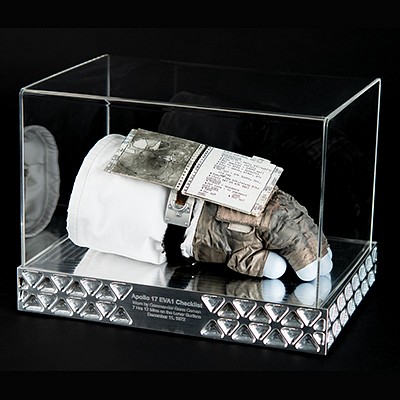Neil Hutchinson's Rolex GMT-Master Wristwatch
Two ways to bid:
- Leave a max absentee bid and the platform will bid on your behalf up to your maximum bid during the live auction.
- Bid live during the auction and your bids will be submitted real-time to the auctioneer.
Bid Increments
| Price | Bid Increment |
|---|---|
| $0 | $5 |
| $50 | $10 |
| $200 | $25 |
| $500 | $50 |
About Auction
Apr 20, 2023
RR Auction support@rrauction.com
- Lot Description
NASA Flight Director Neil B. Hutchinson's Rolex GMT-Master (Reference #1675) wristwatch, worn on a daily basis throughout his career in Mission Control—from Hutchinson's wrist, this iconic timepiece witnessed the key events from the age of Apollo through the early Space Shuttle missions. Serial no. 1533666, movement no. 1432504, the watch was manufactured in 1966 and purchased by Hutchinson in 1967. It features a 26-jewel Oyster Perpetual Movement, black dial, blue-and-red bezel with 24-hour scale (nicknamed the 'Pepsi' color scheme), date indicator with famous Rolex 'Cyclops' magnifying bubble in the acrylic crystal, and original stainless steel Rolex Oyster bracelet (Ref. #78360).
The bezel rotates so that the local time zone and Greenwich Mean Time may be simultaneously represented, a system developed thanks to the age of flight—Rolex collaborated with Pan American World Airways to devise the scheme, so that their long-haul pilots could keep track of both local time and GMT, which was used for all aviation flight planning. In fine condition, with light scratches to the crystal, and expected signs of use. Accompanied by a letter of provenance signed by Hutchinson, plus the original box and rare paperwork—a Rolex GMT-Master instruction booklet, Rolex Superlative Chronometer warranty booklet, tiny Rolex 'auto-lock' bezel pamphlet, and Bureaux Suisses chronometer certification document. The watch received official Rolex authorized service in 2022 (nothing cosmetic done, only lube, etc.).
Hutchinson's letter of provenance provides a detailed chronology of his NASA career and mission assignments, beginning with Apollo 4, continuing through the Skylab program and Apollo-Soyuz mission, and finishing with the fourth flight of the Space Shuttle. In part: "I, Neil B. Hutchinson, certify that Rolex GMT Master watchäó_was purchased by me in the fall of 1967 and has since remained continuously in my possession. It was worn on a daily basis throughout my career in NASA Mission Control. This Rolex GMT served me well in the variety of capacities for which I servedäó_This watch has seen some of the most exciting moments in our early manned space program history."
The watch can easily be seen on Hutchinson's wrist in images from NASA's archives—including one of Hutchinson with astronaut Bruce McCandless II, and another of Hutchinson in the Mission Operations Control Room during Apollo-Soyuz—as well as in a video of a briefing with Christa McAuliffe. Desirable on its own as a classic vintage Rolex, the exceptional provenance and association with NASA's most historic flights—including every manned Apollo mission—make this one of the most intriguing and historically significant space-related timepieces we have encountered. - Shipping Info
-
Bidder is liable for shipping and handling and providing accurate information as to shipping or delivery locations and arranging for such. RR Auction is unable to combine purchases from other auctions or affiliates into one package for shipping purposes. Lots won will be shipped in a commercially reasonable time after payment in good funds for the merchandise and the shipping fees are received or credit extended, except when third-party shipment occurs. Bidder agrees that service and handling charges related to shipping items which are not pre-paid may be charged to a credit card on file with RR Auction. Successful international Bidders shall provide written shipping instructions, including specified Customs declarations, to RR Auction for any lots to be delivered outside of the United States. NOTE: Declaration value shall be the item’(s) hammer price and RR Auction shall use the correct harmonized code for the lot. Domestic Bidders on lots designated for third-party shipment must designate the common carrier, accept risk of loss, and prepay shipping costs.
-
- Buyer's Premium



 EUR
EUR CAD
CAD AUD
AUD GBP
GBP MXN
MXN HKD
HKD CNY
CNY MYR
MYR SEK
SEK SGD
SGD CHF
CHF THB
THB












